Meiosis and Sexual Life Cycles
We have just finished looking at the process of mitosis, which ensures that each cell of an organism has the same DNA as the original fertilized egg or zygote (absent mutations).
Transmitting chromosomes and genetic information from generation to generation is equally important. A critical role of heredity is to maintain and obtain variation among members of a species. These variations are the result of the specific genes we inherit from our parents. We did not always know that genes were located on chromosomes. We didn't even know how genetic information was transmitted from parent to offspring. The mechanism for transmitting genetic information was first proposed by Gregor Mendel in the mid-1800's. It was pretty much forgotten until the early 1900's when Mendel's papers were "discovered" about the time other researchers were drawing the same conclusions based on similar research. Soon after, Walter Sutton showed that Mendel's principles of inheritance applied to chromosomes and that chromosomes are the units of heredity. We shall discuss Mendel's principles and inheritance patterns soon, but first we'll look at how chromosomes are transmitted from generation to generation by the process of meiosis and sexual reproduction.
Although asexual reproduction, which uses mitosis to make new individuals (genetically the same as the parent) is common in protists, plants, fungi and some animals, most organisms produce offspring by a process of sexual reproduction, in which a gamete from one parent joins a gamete from the other parent to form a zygote (or fertilized egg). This process results in offspring that have a combination of parental chromosomes.
However, each generation of a species retains the same chromosome number as the preceding generations. Meiosis is the process that ensures that each new generation has the same chromosome number as the preceding generation.
Meiosis is a process that reduces chromosome number by half and occurs at just one stage in an organism's life cycle (to form gametes in animals, or to start the gamete producing stage in plants, or for some organisms to restore the appropriate chromosome number for the assimilative stage of its life history).
Sexual reproduction then restores the "typical" number of chromosomes for the next generation. In this context, we need to look not just at the process of meiosis, but also take a look at the sexual life cycles of organisms.
In addition to providing a mechanism to reduce chromosome number for sexual reproduction, meiosis has a second, most important function for living organisms: maintaining genetic variation. Each time meiosis occurs, followed by, at some point, sexual reproduction, the new individual is genetically different from either parent. Because meiosis is involved with genetic variation and is needed for sexual reproduction, we will discuss this important genetic function of meiosis as well as its chromosome reduction function in this section.
Meiosis and Sexual Life Cycles - 2
So how does meiosis work?
To answer the question of how meiosis works, we need to first revisit the chromosome. If we look at the chromosomes of most eukaryotic organisms carefully, it can be seen that for each individual chromosome, a second chromosome can be found that physically matches it in length and shape. This is best seen with the karyotype. Closer inspection of the DNA shows that the matching chromosomes have very similar, but not identical DNA. These matching chromosomes, with their similar DNA, form the basis of the variation we see in the genetic traits of living organisms, as well as being a way that we can reduce chromosome number during meiosis and still have the appropriate genetic information in each cell. The matching chromosome pairs are called homologous chromosome pairs, or homologues (homologs).
Cells that contain pairs of homologous chromosomes are called diploid (2n). When a cell has chromosome pairs, we refer to the diploid number of chromosomes, again meaning that each chromosome has a match, or homologue in that cell. For humans, the diploid number of chromosomes is 46. Again, these 46 chromosomes are comprised of 23 homologous pairs of chromosomes.
Following meiosis, the product cells will not have pairs of chromosomes; there will be one of each pair in each cell formed, so the chromosome number will have been reduced by half, and is said to be haploid (n).
By the way, "ploid" as a general term also means a "set", so we can also say that a diploid cell has two sets of chromosomes, or two of each kind of chromosome. A haploid cell has one set of chromosomes, or one of each kind. (It's possible to have more than 2 chromosomes of each kind. Polyploids are quite common in agriculture as a result of plant breeding. Polyploids are less common in animals.)
For many sexually reproducing organisms, one homologous pair of chromosomes does not precisely match in size in one gender, but does match in the other gender. This is the pair of sex-determining chromosomes, or the sex chromosomes. The other pairs of chromosomes do match and are called autosomes. Humans have 22 pairs of autosomes and 1 pair of sex chromosomes.
Meiosis and the Life Cycles of Organisms
Just as each cell has a cell cycle, organisms have a life cycle. For most, the life cycle includes sexual reproduction. Meiosis is something that takes place at just one point in any sexually reproducing organism's life cycle. Meiosis always reduces the chromosome number (typically from diploid to haploid).
Meiosis and Sexual Life Cycles - 3
In animals, meiosis generally occurs to form gametes: sperm or eggs. Egg and sperm are the only haploid cells of animals. In many other types of organisms, meiosis occurs at some point in the life cycle other than the direct formation of gametes, and the products of meiosis may be spores, (as in plants) or the first cells of the next generation (for most protists and most fungi). At some point however, all organisms that sexually reproduce will make haploid gametes (sperm and egg, or different genetic mating types).
Similarly, fertilization occurs at one point in an organism's life history. Fertilization occurs between two different haploid cells, called gametes, to form the zygote, or fertilized egg. The zygote obtains half its chromosomes from the sperm and half from the egg (or half from one gamete and half from the second; yeasts, for example, have a and α gametes, not sperm and egg).
Fusion of gametes restores the diploid number, and in so doing, also restores homologous chromosomes (one of each kind being provided by the sperm and one of each kind coming from the egg). Since each gamete has a unique combination of chromosomes, each zygote will be unique, and genetic variation is both maintained and obtained within the species.
Yet, as mentioned earlier, when meiosis occurs in the life cycle of organisms is not always the same. Let's compare three typical life cycle patterns and look at the timing of meiosis in the life cycle of each.
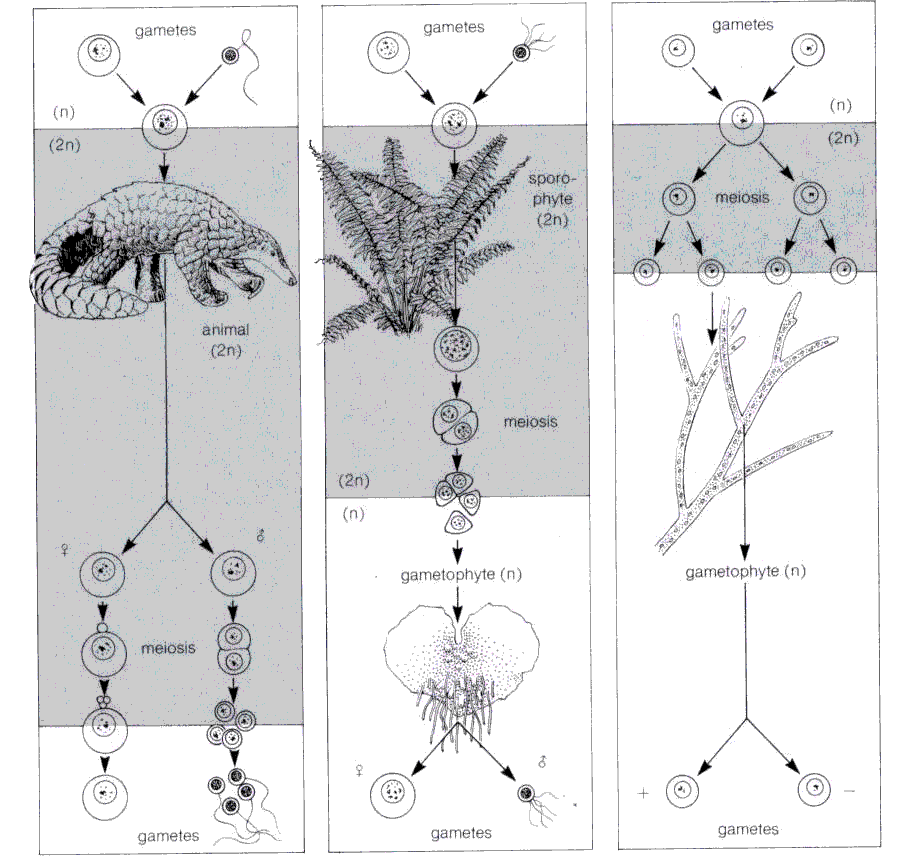
Meiosis and Sexual Life Cycles - 4
Diploid Life Cycle
- In animals, meiosis generally produces just haploid sex cells, or gametes, which at fertilization start the next generation. The only haploid cells of the animal are egg or sperm, and the respective maturation processes are called oogenesis and spermatogenesis.
- When gametes fuse, the zygote grows by mitosis producing the adult stage. All cells will be diploid and all cells are produced by mitosis. The animal life cycle is a diploid life cycle.
Haploid Life Cycle
- In many protists, and some fungi, haploid gametes fuse to form a zygote, but the zygote immediately does meiosis forming single haploid cells.
- In protists, which remain single cell organisms, the nucleus is then haploid.
- At some time, a single cell may just decide to become a gamete and fuse with another to make a zygote, or haploid cells may do mitosis to make more individuals asexually.
- Haploid life cycles can be more complex. Fungi, and some algae may make multicellular haploid organisms from the single-celled meiotic product by mitosis. At some time, special areas of the haploid body will become gametemaking structures (often called gametangia), and haploid gametes are formed by mitosis.
Alternation of Generations
- Most plants have both a multicellular haploid stage and a multicellular diploid stage in their life histories. This is called the alternation of generations. (Since we are humans (and animals), we just haven't had the opportunity to become acquainted with these different forms of a plant's life.)
- In plants, the structure in which meiosis occurs is called a sporangium. The multicellular diploid plants, or parts of plants, that produce sporangia are calledsporophytes (spore-making plant).
- Meiosis does not directly produce gametes, but produces haploid cells, calledspores that in turn, grow, by mitosis, into multicellular haploid structures called gametophytes (gamete-making plant). Gametophytes eventually produce and contain gametes.
- Which stage (sporophyte or gametophyte) is predominant in the life of a plant varies with different types of plants. Most "higher" plants have predominant sporophytes. A pollen grain of pine tree or flower, for example is the male gametophyte stage of those plants. Mosses, in contrast have predominant gametophyte stages. It is easiest to see sporangia and spores on ferns. The fern plant we know (and love) is the diploid sporophyte generation. The sporangia are located on the undersides of leaves. Once one knows what a fern gametophyte looks like, they can often be spotted growing in pots or on the surfaces of pots in greenhouses.
Meiosis and Sexual Life Cycles - 5
On to the Process of Meiosis
Remember, the purposed of meiosis is to reduce the chromosome number by one half at one point in the life cycle of an organism so that following sexual reproduction (fertilization) the "typical" number of chromosomes will be maintained from generation to generation. Meiosis and sexual reproduction are genetic events, critical to maintaining (and obtaining) genetic variation among members of a species. This variation is essential for most organisms so the species can be responsive to changing environmental conditions through time. (More on this later.)
Homologous chromosome pairs are essential to how meiosis works. In meiosis the homologous chromosomes literally pair up prior to the reduction of chromosome number. In meiosis, one of each type of chromosome (one of each homologous pair) is distributed to each meiotic product, so that the meiotic products have half as many chromosomes as the "parent" cell. This is the crucial difference between mitosis and meiosis, and explains why we can reduce chromosome number and still have all of the genetic information needed to form a new organism after fertilization.
Some Notes:
- "Sister" Chromatids are not pairs; they are the two identical parts of one duplicated chromosome. You must make this distinction to understand how the process of meiosis works!
- A pair of duplicated homologous chromosomes will have a total of 4 chromatids, two chromatids for each homologue. It's just a fact that prior to any cell division, chromosomes duplicate, so meiosis starts with duplicated chromosomes.
- After meiosis, the meiotic products have the haploid (half the parental) number of chromosomes, and no pairs of homologous chromosomes. Haploid also refers to the cell when there is just one of each kind of chromosome, or the "n" number of chromosomes. (Diploid is the 2n number of chromosomes.)
- Again, the diploid number of chromosomes will be restored when two gametes (egg and sperm) unite in sexual fertilization.
- In contrast, during mitosis, the DNA is precisely duplicated and each cell formed has exactly the same genes as the original. This means that any offspring that result from mitosis (as with asexual reproduction) are genetically identical to the parent.
- The homologous pairs of chromosomes in diploid organisms do not interact during mitosis; each chromosome is on its own.
Meiosis and Sexual Life Cycles - 6
The Process of Meiosis – Details that Distinguish Meiosis
Just to say it again, during meiosis, homologous chromosomes line up or literally pair with each other. Meiosis reduces the chromosome number by one-half in a way that ensures that the gametes will get one of each pair of homologues. The separation of homologous chromosomes is critical to the process of meiosis. The products of meiosis (such as the gametes in animals) have no pairs of chromosomes and are haploid, since they have half the chromosomes of the parent cell. When fertilization occurs, the diploid number is restored, along with the matching chromosomes.
Prior to any cell division, chromosomes must undergo DNA duplication. To achieve the reduction in chromosome number and appropriate distribution of chromosomes, meiosis requires two divisions, called Meiosis I and Meiosis II.
At the completion of the second division, four cells will typically be produced. The stages of meiosis resemble those of mitosis; the differences occur in the matching or pairing of the homologous chromosomes, which occurs during the first division prophase.
The Stages of Meiosis (Or how we break up a continuous process into chunks)
Meiosis is comprised of two divisions each with a prophase, metaphase, anaphase and telophase. In addition, meiosis is preceded by pre-meiotic interphase in the germ-line tissue and an interkinesis between the two divisions.
Pre-Meiotic Interphase
The DNA of the cell* that will do meiosis duplicates. (DNA duplication must precede any cell division.) The identical sister chromatids of each duplicated chromosome are attached at their centromeres and have their kinetochores.
* Cells that do meiosis are restricted to specialized structures such as the sex organs (ovary and the testis) of animals; or anther and ovule (which are specialized sporangia) of "higher" plants; or sporangia of "lower" plants. These tissues are often referred to as the "germ-line tissues". These tissues are diploid, just as is the rest of the organism. Only the products of meiosis (gametes or gamete-producing structures) are haploid.
Note that some organisms have a haploid life cycle; most of their assimilative life is spent with cells that are haploid. Meiosis immediately follows the formation of the zygote. The haploid cells produced are the first cells of the next generation, which grow by mitosis to become adults.
Meiosis and Sexual Life Cycles - 7
Meiosis I
Prophase I
Prophase I has been further broken down by some into four subphases: leptotene, zygotene, pachytene, and diplotene, plus one more: diakinesis.
Leptotene
Duplicated chromosomes condense
Zygotene
Homologous chromosomes pair up along their length at the start of prophase I in a process called synapsis. This uses a protein lattice along the chromosomes to join the homologues together. The homologues literally join at several points (called chiasmata). All four chromatids of the homologous pair are aligned together, forming the synaptonemal complex.
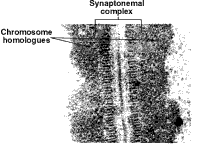
Pachytene
The synaptonemal complex allows for a process of genetic importance to occur. Portions of intertwined chromatids of the homologous chromosomes unwind and the single-stranded DNA molecule sections base-pair to complementary strands of a non-sister chromatid of the homologue. This results in an exchange of DNA portions between the homologous chromosomes with the structure of the synaptic complex. This exchange is called crossing over. Crossing over occurs between the non-sister chromatids, and is mediated by enzymes. If the specific DNA of the homologues were different forms of genes, then recombination occurs. The sister chromatids now have some genetic variation; they are no longer precisely identical.
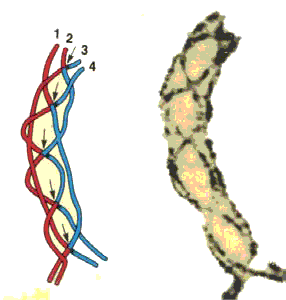

Meiosis and Sexual Life Cycles - 8
Diplotene
After crossing over takes place, the still-joined homologues pull apart, decondense and active cell growth activities occur, including transcription of genes, gearing up for the divisions to follow. Homologous chromosomes are still attached at the chiasmata, however.
Diakinesis
As homologous chromosomes ready for migration to metaphase I, transcription activities ceases, and homologous chromosome pairs recondense.
In addition, all things that we normally think of taking place in a prophase also occur in prophase I of meiosis, including attaching spindle microtubules to each chromosome of the attached homologous pairs. But, spindle microtubules do not attach to each kinetochore of each chromatid!
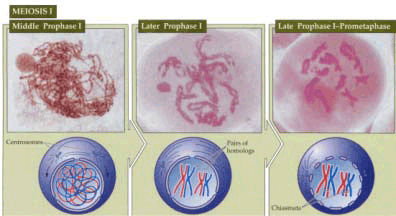
Metaphase I
- Homologous pairs of chromosomes, still synapsed, are moved to the equator by the spindle complex. The chiasmata ensure that homologous chromosome pairs align as pairs.
- The alignment is random; some "maternal" chromosomes will orient facing one pole along the equator; others face the opposite pole.
- Spindle microtubules just attach to homologous chromosomes as they find them from the respective poles of the cell. They do not attach to both homologous chromosomes.
Meiosis and Sexual Life Cycles - 9
Anaphase I
- The homologous chromosomes are separated from each other and pulled toward opposite poles by the microtubules.
- Since spindle microtubules have attached to just one kinetochore of each duplicated chromosome, duplicated chromosomes are pulled as a unit. The duplicated chromosomes are not affected during Anaphase I.
- The sister chromatids are still tightly bound to each other by their centromeres.\
- The chromosome number is officially reduced at this time because each nucleus that will form around the set of chromosomes at each pole will have half the number of chromosomes as the pre-meiotic cell. All of the chromosomes will still be duplicated. No sister chromatids have separated.
- No homologous chromosome pairs are present at the end of Anaphase I. Each cluster of chromosomes at the respective poles of the cell will have one of each type of homologous chromosome. It is the pairing and separation of homologues that is the key to reducing chromosome number while maintaining all of the genetic information.
- Genetic variation is increased as a consequence of the random alignment of homologous chromosomes at metaphase I and separation of homologous pairs in anaphase I. This is called random assortment, and is important for genetic variation.
Telophase I and Interkinesis
- Typically two new nuclei are formed, each with one set of the homologous chromosomes
- Cytokinesis typically will form two cells. (Each chromosome is still duplicated; this occurred in pre-meiotic interphase.) Essentially the cells are just preparing for the second division. Some cells do not bother with cytokinesis here, or even form new nuclear envelopes, which will just have to be degraded during meiosis II anyway.
- Genetically speaking, the two cells formed are not identical �?? recombination and independent assortment activities result in non-identical chromatids in the two cells.
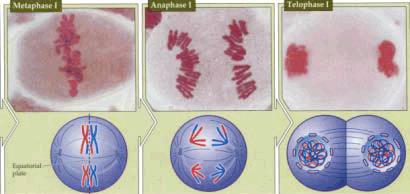
Meiosis and Sexual Life Cycles - 10
Meiosis II
Prophase II
- New spindle apparatus is formed in each of the two cells from telophase I
- The still-duplicated chromosomes stretch out and then recondense
- Spindle fibers attach to the kinetochores of each of the sister chromatids, one from each pole.
Metaphase II
- The duplicated chromosomes are aligned along the equator by the spindle complex
Anaphase II
- Centromeres of sister chromatids are detached from each other.
- The now non-duplicated chromosomes are pulled to the poles of the cells.
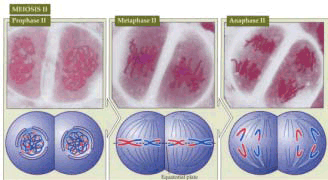
Telophase II and Cytokinesis
- Each new nucleus formed has half the number of the original chromosomes but each nucleus has one of each type of homologous chromosome.
- A total of four new cells will be produced.
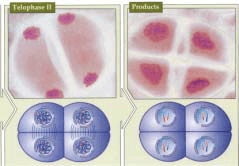
Note: Meiosis II as a mechanism is just like mitosis; duplicated chromosomes are distributed equally into new cells, each with the same number of chromosomes as the original. The difference is that you are starting with two cells, and forming a total of 4 new cells.
Meiosis and Sexual Life Cycles - 11
Reviewing the genetic importance of meiosis and sexual reproduction
We have discussed that chromosomes occur as homologous pairs, which are physically matched. The homologous pairs of chromosomes are also matched genetically; each homologous chromosome has a gene locus for a specific trait, so that a diploid organism typically has two pieces of DNA for each genetic characteristic, one on each of its homologues.
During meiosis there is some shifting and recombining of alleles so that new gene combinations always occur in the gametes that are different from the parent.
In sexual reproduction, each parent typically has two "genes" (or more correctly, two alleles of a gene) for each characteristic, one on each of the homologous chromosomes. Each parent passes one of these genes (but not both) and one of each of its homologous chromosomes to the offspring by meiosis and fertilization. The fertilized egg (zygote) will then have two genes for each trait, one from each parent. It's important to note that each individual will have apaternal set of chromosomes and a maternal set of chromosomes. Each homologous pair of chromosomes has one paternal and one maternal origin.
Since parents are not genetically identical, their gametes will have different combinations of genes. Each egg and each sperm (or each spore) is genetically different from the parent's DNA (having only half as much). The offspring (children) formed by sexual reproduction will have genetic variation, important for the long-term response of species to their environment. Such variations among offspring lead to physical, behavioral and physiological differences. These differences may be more or less useful in the surroundings of that organism, and are subject to the agents of selection. This variation is an important basis for evolutionary change.
Meiosis and Sexual Life Cycles - 12
Further genetic variation is achieved during meiosis when homologous chromosomes synapse during prophase I and recombination occurs so that sister chromatids are no longer precisely identical. Each of the four meiotic products formed will be a bit different as a result of this recombination.
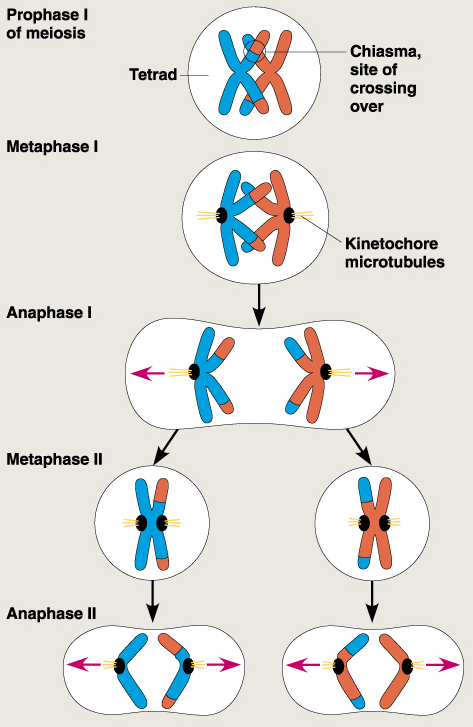
Another source of genetic variation in meiosis is the alignment of homologous chromosomes at the equator during metaphase I. Some maternal chromosomes will align towards one pole and some towards the other pole. Depending on this alignment, chromosomes assort differently, relative to maternal/paternal origin during each meiotic event. This is known as Independent Assortment, and is "easily" demonstrated in inheritance tests. The number of possible independent assortments of the 23 pairs of human chromosomes is 223 or about 8 million.
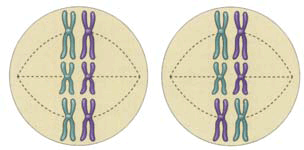
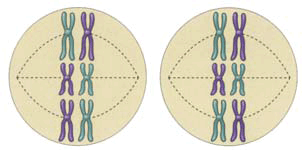
Independent Assortment of Homologous Chromosomes in Meiosis
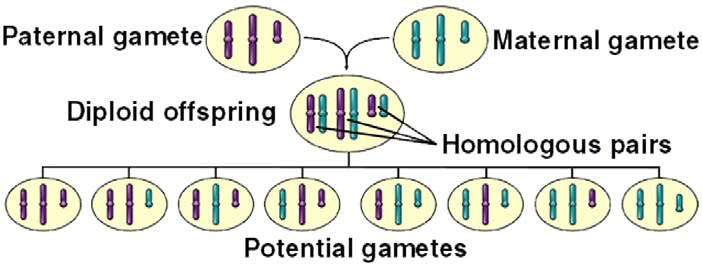
Meiosis and Sexual Life Cycles - 13
Final Note: Not all organisms reproduce sexually. Many organisms have both sexual and non-sexual means of propagation, or increasing the numbers of individuals. Although non-sexual reproduction increases numbers of individuals, all have virtually the same genetic complement.
Development of eggs without fertilization occurs in both plants and animals.
Haploid eggs of bees become males while fertilized eggs become females. In plants, development of embryos without fertilization is called apomixis, in animals, parthenogenesis. Many invertebrates have parthenogenesis, as does the rare vertebrate.
Asexual reproduction, which uses mitosis, can be a good strategy in an environment that is constant if a species is well-suited to those conditions.
Dandelions, for example, rarely reproduce sexually; their seeds develop without fertilization. They are highly successful in the suburban lawn. And suburban lawn owners spend a lot of time making sure that their lawn looks just the same year after year, carefully applying water and nutrients several times each growing season. This is perfect for dandelions. Sexual reproduction might introduce variation that could result in a dandelion less fit for the suburban lawn. Without sexual reproduction, however, there can be little genetic variation, most species without genetic variation cope poorly over time with changing environments. (This is not always the case with microorganisms that can mutate and reproduce rapidly.)